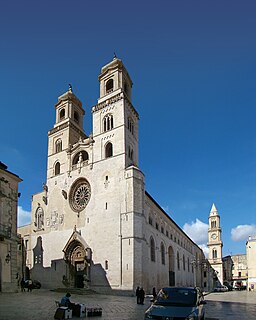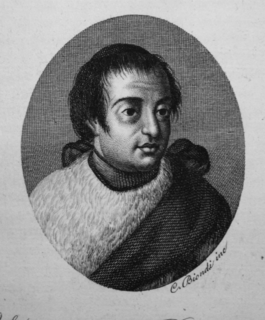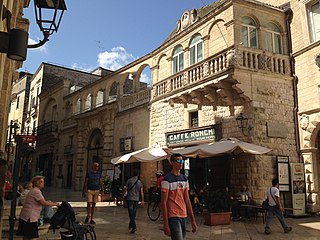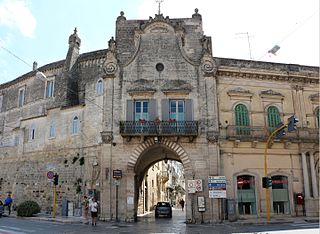
Altamura is a town and comune of Apulia, in southern Italy. It is located on one of the hills of the Murge plateau in the Metropolitan City of Bari, 45 kilometres southwest of Bari, close to the border with Basilicata. As of 2017, its population amounts to 70,595 inhabitants.

Altamura Cathedral, dedicated to the Assumption of the Blessed Virgin Mary, is a Roman Catholic cathedral in the city of Altamura, in the Metropolitan City of Bari, Apulia, in southern Italy.

Altamura Castle was a castle located in the city of Altamura, now completely demolished. It was located over today's piazza Matteotti and a few remains of it are still visible inside the adjacent buildings, which were built partly with stones and structural elements from the castle. In a warehouse are an ogival arch and some stone coats of arms. A few other remains are found in the adjacent buildings, which were built in the 19th century.

Pulo di Altamura is a doline located on the Murge plateau. It is the largest doline in that region and it is located about 6 kilometers (3.7 mi) north-west of the city of Altamura. It shares the local toponym pulo with other large dolines of the region, i.e. Pulicchio di Gravina, Pulo di Molfetta and Pulicchio di Toritto.

The Altamuran Revolution was a three-month period of self-government of Italian town Altamura, right after the birth of the Parthenopean Republic which ousted the Bourbons and the Kingdom of Naples. The city of the Kingdom of Naples was then defeated and taken by the so-called Sanfedisti, led by cardinal Fabrizio Ruffo, after a battle on the city walls. After being defeated, most Altamurans managed to flee through Porta Bari, one of Altamura's main gates.

Gioacchino de Gemmis was a Catholic bishop, archpriest, prelate and rector of the University of Altamura. He's best known for his role in the so-called Altamuran Revolution (1799), advocating peace and helping the refugees, who had fled Altamura after the battle with the Sanfedisti, to be allowed in Terlizzi.

Vitangelo Bisceglia was an Italian botanist, agronomist and professor. He taught inside the University of Altamura. Because of his being a polymath, he's been described as "an encyclopedic spirit, the honor of the Muses".

The University of Altamura was a former university located in Altamura, Apulia, Kingdom of Naples. It was established in Altamura in 1747 by Charles III of Bourbon, following the idea of the archpriest of Altamura Cathedral Marcello Papiniano Cusani. It was officially closed in 1812, mainly due to the lack of funds, even though some documents kept inside library Archivio capitolare in Altamura show that professors continued to teach until 1821.

Piazza del Duomo is the main square of the city of Altamura, Italy. It is located in the center of the historic city center, as well as in the middle of the main street of the city, that is corso Federico II di Svevia. Moreover, Altamura Cathedral, the main church of the city, is located on the square. It is also known because the Tree of Liberty was planted in this square during the so-called Altamuran Revolution (1799).
Onorato Candiota was an Italian professor of philosophy and math at the Real Convitto di Bari, in Bari, Italy. He lived between the 18th and 19th centuries. The exact dates and places of birth and death are currently unknown, even though it is known that he was from Altamura, Italy. He's best known for his participation in the so-called Altamuran Revolution (1799). He died short after 1808.
Francesco Maria Bovio was an Italian lawyer, judge and professor. He's best known for being the grandfather of Italian philosopher Giovanni Bovio (1837-1903). He also fought for the Parthenopean Republic (1799) during the Altamuran Revolution (1799).

The Megalithic Walls of Altamura are defensive walls dating back to the 4th century BCE. They were the city walls of the ancient city of Altamura, Italy. Nowadays, only a few parts of the original wall remain; the original track of the wall spanned over a length of about 3.6 km. They were about 4 meters high, while the base of the walls was about 5 meters wide.

Giovanni Pipino di Altamura was an Italian nobleman and condottiero. He belonged to the Pipino noble family, which began with Giovanni Pipino da Barletta and that, after just a few decades, declined.
Giovanni Pipino da Barletta was an Italian nobleman and dignitary of the Kingdom of Naples. He started the Pipino noble family, which, after just a few decades, disappeared with the death of his grandson Giovanni Pipino di Altamura and his brothers.

Porta Bari, previously called Porta de Bari, was one of the main gates of the city of Altamura, before the city walls of the city were torn down over the 19th century. Similarly to most European cities, the city walls were torn down, because the new technology and military techniques employed starting from the 19th century made them useless for defense purposes.

Domenico Sacchinelli was an abbot of the Catholic church. He's best known for having followed and helped Fabrizio Ruffo and the Sanfedisti army to restore the Kingdom of Naples and the Bourbon dynasty, after the short-lived Parthenopean Republic (1799). In 1836, after a few decades, he published his memoirs of that period, titled Memorie storiche sulla vita del cardinale Fabrizio Ruffo.
Giuseppe Carlucci was an Italian professor and astronomer. He was one of the first professors teaching at the University of Altamura (1747-1812).

Francesco Cassiano de Silva was a Spanish engraver. His engravings mainly depicted some cities of the Kingdom of Naples and they represent an invaluable source of information on the history of Southern Italy.

The City Walls of Altamura were a military structure meant for defensive purposes and located in the city of Altamura, Italy. Its origin dates back to the Middle Ages and it was in use until the 19th century when it started to be gradually torn down. Nowadays only a few isolated parts of the walls survive. It shouldn't be confused with the Megalithic Walls of Altamura, which date back to the 5th–4th century BC and intersect in some parts with the city walls.
Giuseppe de Samuele Cagnazzi was an Italian politician of the Kingdom of Naples. He was an inspector and director of the customs department of the Kingdom of Naples. He was the elder brother of Italian scientist and economist Luca de Samuele Cagnazzi.


















